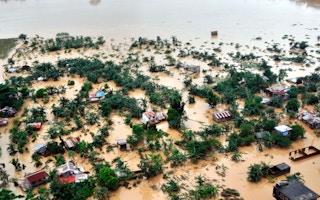Countries across Asia are sitting up to take notice of the benefits of building green due to reasons ranging from the increasing pace of urbanisation to the increased vulnerability to climate change effects such as floods.
Seven experts from different countries at the opening plenary of the three-day International Green Building Conference on Wednesday at Singapore’s Marina Bay Sands said that despite the difference in size, demography, and public attitudes to green building in these countries, there are some common challenges and solutions for Asia.
Most importantly, said the speakers, their respective countries had individually concluded the importance of green building, or were arriving at that conclusion.
For some, climate change has gotten all too close to home. Philippine Green Building Council chief executive, Christopher de la Cruz, pointed out that his country is one of the most vulnerable to climate change.
“I grew up in Manila, and much of my experience as a school kid was navigating floods,” he shared. The Philippines has one of the longest coastlines in the world, and with 60 per cent of the population living along that coastline, there is a need to look at real solutions for surviving climate change in years to come.
“We need to have a blueprint for ensuring this, and green buildings are part of the agenda,” he said.
Other speakers such as Dr Wang Jianting, the vice president of Tianjin Chengjian University, shared that China’s green building drive stems from the recognition that China is supporting a much bigger population on less land and less water than the comparable nations of Russia and the United States.
As urbanisation picks up pace and a growing number in the population migrate to cities, resource and energy consumption will inevitably shoot up and this will exacerbate China’s existing challenges in environmental degradation, depleting natural resources, and pollution.
“Our building industry has to respond to this change (towards urbanisation) and transform itself,” he said.
The importance of leadership
One common theme in the speakers’ presentations was the key role that leadership, whether by the government, the industry or by NGOs, plays in advancing the green building agenda.
In China and Singapore, the growth of green buildings is directed by government-developed masterplans and action plans that set out clearly defined targets and strategies for achieving those targets.
Singapore’s Green Building Masterplan, for example, offers various government-funded incentives to encourage the industry to adopt green building. In the same vein, Dr Wang pointed out that the Chinese central government’s policies to promote green building leadership require a lot of government funding and incentives, all the more so as the Chinese construction industry continues growing at a tremendous pace.
In Malaysia, the government took the lead by endorsing a green building rating system, the BCA Green Mark developed in Singapore. Deputy chairman Sam Tan of the Real Estate and Housing Developers Association (REHDA) Youth Wing also noted that although cash incentives are negligible in Malaysia, REHDA, which is the national representative body for property developers in the country, plays a leading role in actively engaging developers and industry professionals to promote the value of green buildings.
In Thailand, the Thai Green Building Institute published the TREES-NC (Thai’s Rating of Energy and Environmental Sustainability) rating system last year, which is paired with government incentives that increase the floor area of compliant buildings.
Thirawat Sarindu, president of Inter Engineering Management, said that these incentives are currently being tried out in Bangkok and, if successful, will be extended to the rest of the country.
On the other hand, a lack of leadership can leave green building efforts floundering.
Ashok Lall, the principal of Indian architecture practice Ashok B Lall Architects, which specialises in sustainability and energy conservation, raised the issue of “wrong messages” which result from insufficient policy support.
He cited existing buildings with excessive energy consumption and proposed high-rise, high-density residential developments that encourage car usage instead of public transport that receive platinum ratings for green building. “How can we accept that as the norm for a large country like India, how can we give that a platinum rating? That’s not right,” he said.
Changing attitudes over time
Countries which have adopted green building policies only recently, or where such policies are not yet widely implemented, face a number of obstacles.
“
We now have data and information to show that if you have the proper design, your building may cost a bit more, but your end-use costs will go down
Lee Chuan Seng, Beca Asia
In Indonesia, where green building has been implemented since 2010, it is still such a new concept that much of the framework for encouraging it is not yet in place, according to Ignesjz Kemalawarta, the director of Indonesian real estate development firm Sinar Mas Land.
There are few green building professionals in Indonesia and green materials are not easily available, nor is the green building approach well known. Furthermore, regulations and government incentives pertaining to green buildings are not fully implemented.
Other speakers, however, said that they had observed attitudes changing over time – partly due to a greater recognition of the impact of climate change, the greater availability of information on the quantitative value of green buildings, and also due to green buildings becoming more common around the region.
Philippine Green Building Council’s De la Cruz said: “Ten years ago when we were striking out, most of our policymakers would ask: ‘What do you want me to address first? Public education or green buildings? Public health or green buildings?’ But in recent years, they have started acknowledging that green buildings can be a solution to many of these problems.”
For those countries where policymakers and the industry are already on board, speakers said that the next step is to convince end-users: owners, investors and the general public.
REHDA’s Sam Tan remarked that although there is no shortage of developments going on for green ratings in Malaysia, there is still a public impression that high green ratings are expensive.
The solution, he suggested, is for developers to simply continue pursuing high ratings, so as to normalise the costs of green buildings. “The message which it sends out to people is: look everyone, we can afford a green building,” he said.
Similarly, in Indonesia, said Kemalawarta, building owners tend to perceive that there is a high cost attached to green buildings. In the absence of strong industry support, he suggested that the government help owners offset the additional upfront costs.
Lee Chuan Seng, the emeritus chairman of engineering consultancy Beca Asia, said that this perception also exists in Singapore, but the research exists to disprove it. “We now have data and information to show that if you have the proper design, your building may cost a bit more, but your end-use costs will go down,” he explained.
When a green building movement has advanced to this point, Lee added, it must take into consideration how to educate end users about behaving in a sustainable way.
Singapore’s Green Building Masterplan, the third since 2006, for example, currently focuses on that. “You can design green and you can build green, but if the end users don’t use green, it means nothing,” he said.
Eco-Business.com’s special event coverage of the International Green Building Conference 2013 is brought to you by City Developments Limited (CDL).






















